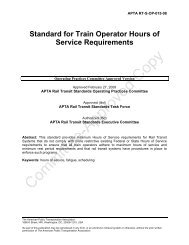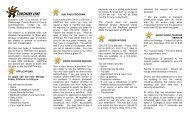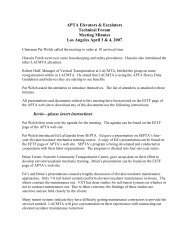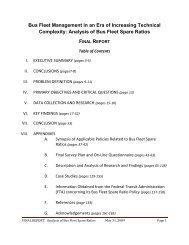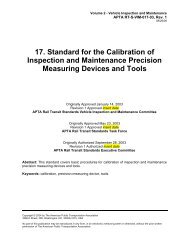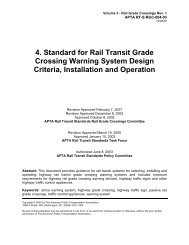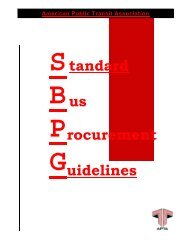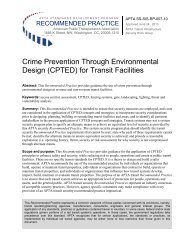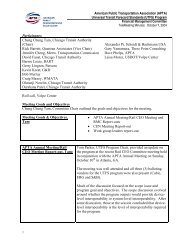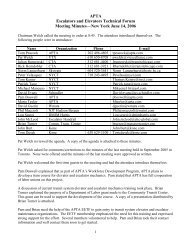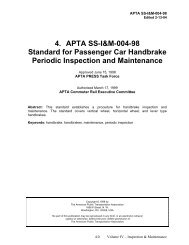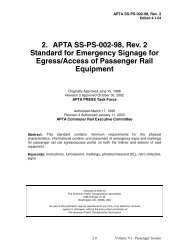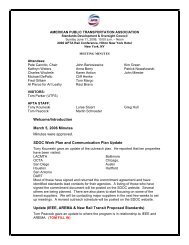Table of Contents - APTAStandards.com
Table of Contents - APTAStandards.com
Table of Contents - APTAStandards.com
You also want an ePaper? Increase the reach of your titles
YUMPU automatically turns print PDFs into web optimized ePapers that Google loves.
Following the authentication process a session<br />
key is generated for each transmission.<br />
All data transfers are also encrypted against eavesdropping.<br />
4.7.8 Timing<br />
and Routing<br />
The TransLink ® system architecture i l structure with the TransLink ®<br />
Central System (TCS) at the top. The T d to all platforms at the next tier<br />
rough Headquarter Computer Systems (HCS). An HCS has connections to, and<br />
anages many TransLink ® s a hierarchica<br />
CS is connecte<br />
th<br />
m<br />
Data Servers (TDS). The TDS manages one or more Card<br />
Interface Devices (CID)<br />
or Distribution Devices (AVM).<br />
Each node at a tier in the system <strong>com</strong>municates to all subordinate nodes and has a<br />
single connection to the next higher tier. This requires all transactions in the TransLin<br />
Fare Payment System (FPS) to be transported through each processing tier before<br />
arriving at the TCS. The processing requirements <strong>of</strong> each level<br />
determine what<br />
transactions<br />
are filtered and formatted into database structures.<br />
All messages<br />
must be forwarded to a higher<br />
level until they reach the TCS. For<br />
example, a message generated at a device is submitted<br />
to the TDS then forwarded to the<br />
HCS. The HCS then has the responsibility for sending<br />
its transactions to the TCS.<br />
provides four different date definitions in operation cycle as follows:<br />
TransLink ®<br />
• Operating<br />
Date<br />
• Business<br />
Date<br />
• Reconciliation Date<br />
• Settlement<br />
Date<br />
T he current operating date is a date tha t may be different from the current calendar<br />
date. For example, the current cal endar date may already be 18 February<br />
2004, at 1:00<br />
am, but the current operating date is still 17 February 2004 because the operating<br />
date<br />
changes eve ry day at 3:00 am.<br />
The transaction business date is generated by a device, and added to the transaction<br />
at<br />
the TDS level. It is the current operating date <strong>of</strong> the device or TDS acquiring the device<br />
UD. Typically, business dates reflect the operational business date <strong>of</strong> a transit<br />
operator—the<br />
period <strong>of</strong> their normal daily business hours. For example, if a transit<br />
oper ator operates from 6:00 am to 2:00<br />
am, (their business day), the business date<br />
changeover will occur at 2:00 am. This allows the system to generate operational reports<br />
that reflect transaction/passenger loads tied to their operational schedules. The<br />
business date usually is applied at the devices or the TDS because these nodes typically<br />
operate <strong>of</strong>fline. The business date is typically incremented during the<br />
transit operator<br />
end-<strong>of</strong>-day<br />
process.<br />
The reconciliation date is added to the transaction<br />
at the transit operator level. It is the<br />
current operating date on the transit<br />
operator’s central system. This date is used to<br />
Page 57<br />
k ®



